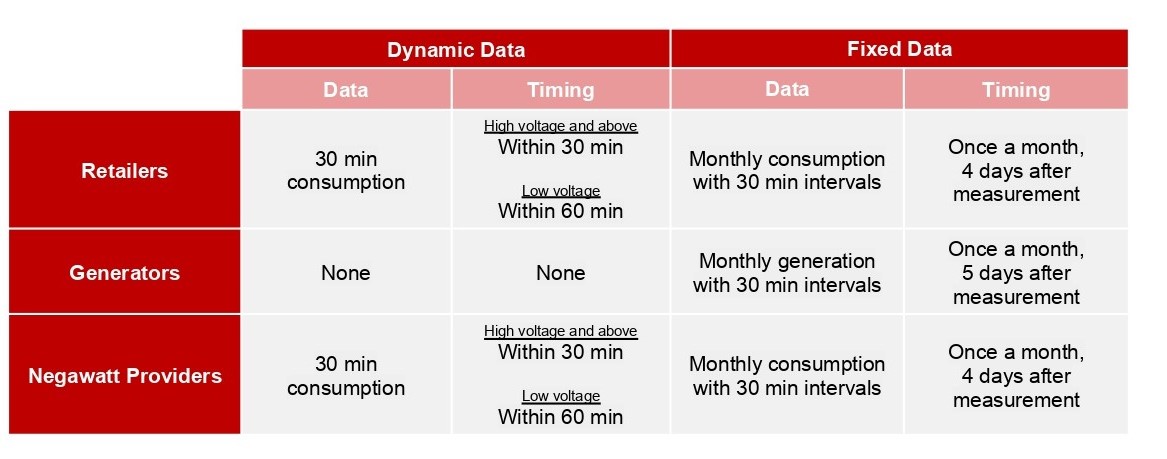Efficient reform and decarbonization of the Japanese power system requires an increasing amount of data, tending toward a real-time measurement of power generation and consumption at each point of the grid. With this in mind, from April 1st, 2014, Japanese power companies were required by the government to begin deploying smart meters across Japan, following the revision of the law on “efficient use of energy aiming for a stable power supply.” Since then, most customers have been provided with a smart meter, and the full rollout should be complete by 2024. The use of the collected data is still evolving, and more data will be provided as upgrades to existing smart meters are installed from 2024 onwards. As the power industry adapts to the energy transition and changing technology, smart meters are likely to be at the center of the development of new businesses and services.
The Roll-Out of Smart Meters in Japan
METI required the installation of smart meters from April 2014 onwards to allow for the recording of power flow with higher granularity. This data can be the basis for new businesses and can help facilitate the spread of decentralized power sources such as solar and EV batteries. By 2016 all high voltage consumers had been equipped with smart meters (~750,000 units deployed). And by FY2020, TEPCO had also completed installation for all its low-voltage consumers. Other T&Ds have been slower in their roll-out but will be done by FY2024 (FY2022 for Chubu and Kansai areas and FY2024 for Okinawa). Once the roll-out is over, 77.5 million meters will have been installed for low-voltage consumers nationwide.
The installation and replacement of smart meters are the responsibility of the T&Ds. Regulations currently put smart meter lifetime at ten years. The T&Ds usually outsource the installation work to several electrical service companies (for example, TEPCO power grid outsources to 23 different providers). The smart meters themselves cost ~¥10,000 per unit (analog meters cost ~¥6,000) and are sourced mainly from ten Japanese manufacturers.
Smart Meter Functions and Data Access
Any electric power meter that is used for the trading of power must be certified according to the Japan Electric Meters Inspection Corporation guidelines.
Current smart meters can record the following data:
- Meter identification (ID of equipment, Date of installation/removal of equipment, and Location information)
- Power data (ID of equipment, Date, Category of current, and Power usage volume every 30minutes)
The data is typically accessed in three different ways (see Figure 1):
- Route A is the direct communication between a smart meter and the corresponding T&D.
- Route B is the communication between a meter and some specialised equipment at the consumer’s site (often some Home Energy Management System, Echonet Lite protocol is often used in Japan) – done in real time.
- Route C is the communication between the T&D and any authorised third party. Power retailers get the data by this route. The data is usually delayed by 60 minutes.
Currently, only T&Ds, consumers and retailers can access the data of their authorized meters in real time (or close to real time depending on the route). Generators can access generation data only once a month after it has been compiled by the T&D. However, from 2022, OCCTO has instructed T&Ds to provide real-time data to generators.
The Evolution of Smart Meters in Japan
The next generation of smart meters is already under discussion and METI expects that after 2024 existing smart meters will gradually be replaced with new models incorporating the following functions:
- Record power usage every 5 minutes
- Last Gasp function
- Able to change to maximum power intensity allowed on the meter
- Record and save the last 60 minutes’ worth of consumption data with a 1-minute granularity on route B
- Options to select and change the format of data transmitted
- Additional connection protocols (Wi-Sun, U- BUS Air etc.)
The goal is to expand and further leverage the data collected to increase grid resilience, the penetration of renewable energy, and the emergence of new services.
The Japanese government is also setting up a new data system that collates and analyses the smart meter data, called the Grid Data bank. The system will begin aggregating data in the fourth quarter of 2022, and the Grid Data Bank should start operating in the first quarter of 2023.
In the event of damage caused by a natural disaster such as a typhoon, the Grid Data Bank will enable T&Ds to easily share with local governments any data related to the state of the power network. In turn, local governments can use this data to efficiently guide evacuations, assess the number of vacant homes to ensure evacuation, and identify available power sources in an area. This data might also be used by third parties after being anonymized. The Grid Data Bank is still in its design phase, although the data is already being collected by the T&Ds.

Outlook
By 2024 every customer should be connected to the grid with a smart meter in Japan. METI is already planning for the next generation of devices to roll out in 2024. They should prove a cornerstone for the emergence of new services in the power industry and the evolution of the power market – with faster, more granular, and more localized trading options. The development of behind-the-meter equipment and services and the change in regulations that will allow access to the data from these devices might also change the way the data from smart meters is used. As always, we will keep monitoring the changes in these fields.
